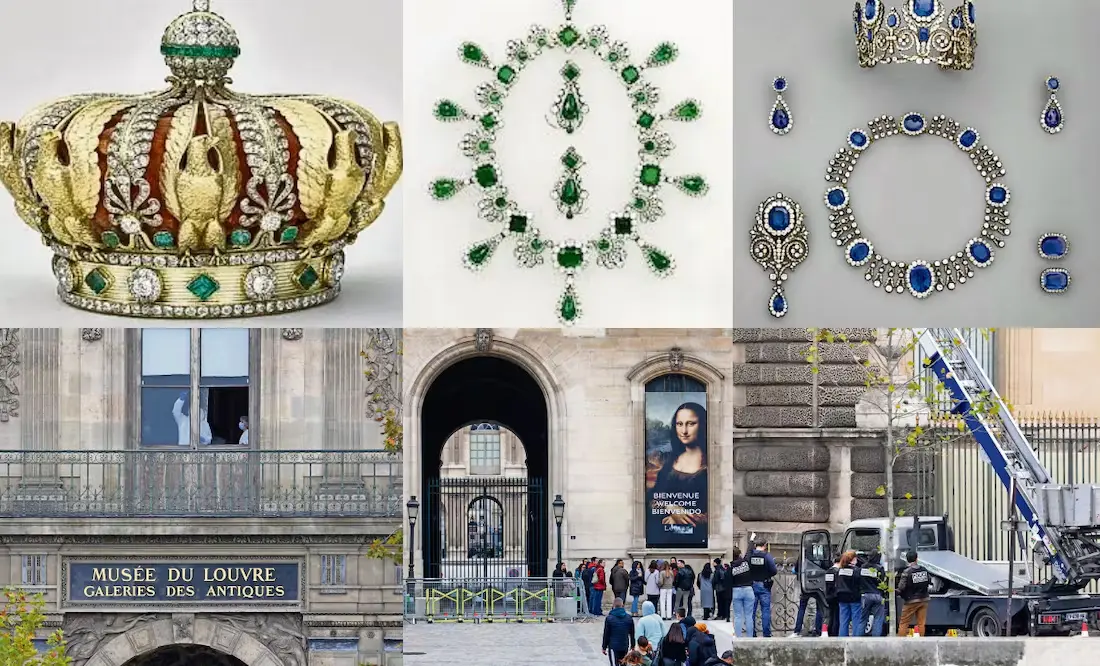Following the shocking broad daylight theft of nine pieces from France’s royal collection at the Louvre Museum yesterday, museum specialist Graciela de la Torre—an academic, historian, and former director of Mexico’s National Museum of San Carlos, National Museum of Art, and University Museum of Contemporary Art—has pointed out the “clear weaknesses” in the Louvre’s security systems.
According to France’s Minister of Culture Rachida Dati, the theft occurred between 9:30 and 9:40 a.m., lasting just four minutes, carried out by a group of four masked individuals who escaped on scooters. The robbers used a truck with a lift to climb one of the museum’s façades, broke a window, smashed display cases, and fled with the jewels after threatening guards with power tools.
President Emmanuel Macron called the theft “an attack on our heritage, something we treasure as part of our history.” The stolen items—taken from the Gallery of Apollo, home to the museum’s most valuable jewels—include two tiaras (belonging to Queens Marie-Amélie and Hortense), sapphire and emerald necklaces, earrings, and brooches from Empress Eugénie and Queen Maria Luisa. The crown of Empress Eugénie, however, was dropped during the heist and later recovered with damage.
The Paris prosecutor, Laure Beccuau, suggested that the crime was likely a commissioned theft, potentially for a private collector or to dismantle and sell the precious stones separately. The thieves escaped within seven minutes, abandoning the burned-out truck near the museum.
The Louvre—the most visited museum in the world—remains closed while the investigation continues. The heist occurred just 30 minutes after opening, with visitors already inside, and amid staff complaints about understaffing and excessive visitor numbers. Macron reiterated on social media that “all efforts are being made to recover the works and bring those responsible to justice.” He added that the Louvre Nouvelle Renaissance project, announced earlier this year, includes funding for upgraded security and modernization—a €700 million investment.
French Interior Minister Laurent Nuñez-Belda admitted that the theft exposes the “vulnerability” of the nation’s cultural institutions and has deployed a national security plan for museums.
Graciela de la Torre called the thieves “geniuses,” comparing them to Vjeran Tomic, the so-called “Spider-Man of Paris,” known for previous high-profile art thefts. “Their alarm systems failed again,” she said. “They must review and modernize them. For the kind of treasures they house, the Louvre’s security simply isn’t reliable enough.”
De la Torre also speculated the theft was likely a premeditated commission with a buyer already secured, noting parallels to Latin America’s black market for pre-Hispanic artifacts.
The Louvre robbery follows a wave of museum thefts in France in recent months:
-
On September 16, thieves stole €600,000 worth of gold nuggets from the National Museum of Natural History in Paris.
-
On September 3, robbers snatched three Chinese ceramics worth €6.5 million from the Adrien-Dubouché Museum in Limoges.
-
In November 2024, armed men attacked the Cognacq-Jay Museum in Paris in broad daylight, stealing over €1 million in jewels, some on loan from the Louvre and the British Royal Collection.
-
And in October 2024, the Jacques Chirac Museum in Corrèze suffered two separate thefts just days apart, losing watches and jewelry worth over €1 million.
“This is a wake-up call for museums everywhere,” said De la Torre. “After a fire, theft is the worst thing that can happen to a museum. We must ask ourselves: do our institutions have alarms, trained security, and proper surveillance? Because this could happen anywhere.”
(With information from international agencies)



